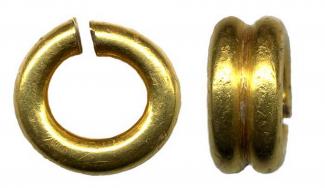Gold penannular ring
Bronze Age, about 1300-1100BC
Found with a metal detector at Exton, Hampshire in 2001
This interesting item from the Middle Bronze Age was produced from two circular-sectioned gold penannular rings joined together, possibly with solder. It is an example of the high quality of the goldsmith's art at this time in prehistory. Bronze Age penannular rings have sometimes been called ring-money, as they resemble metal rings used as currency in West Africa from the 15th to the 20th centuries. However, there is no evidence that they were thought of as currency during the Bronze Age. They are certainly ornamental objects and it has been suggested that they were worn as high status jewellery, perhaps earrings, or tied into the hair. Currently, there is no firm evidence for quite how they were used.



